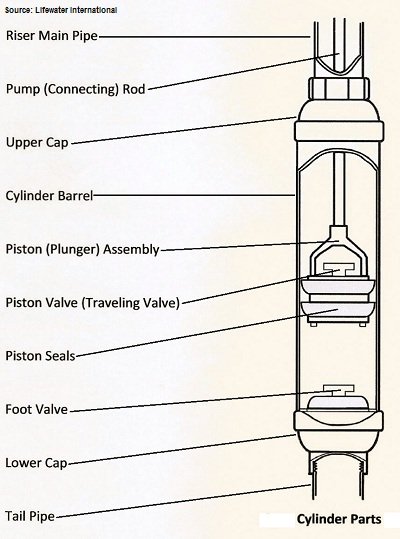Hand Water Pump Components Are Similar Among Piston-Type Pumps
Hand water pump parts and components are made by a number of manufacturers.
Although the design and materials of various piston-type pumps may differ, the number and function of the different parts remains fairly constant.
Differences can be seen in the ease of construction and maintenance.Some hand pumps are much easier to repair and maintain than others.
The parts listed below, however, can be found in one form or another in almost every piston-type hand water pump.

Components of Piston-Type Hand Water Pumps
Riser Main Pipe – This is the vertical pipe through which water is pumped from the water table to the pump head.
Usually in the range of 1 ½ inches to 2 ½ inches in diameter, it can be steel pipe sections threaded together or PVC pipe sections usually glued together.
In closed-top pump cylinders, the riser main is a smaller diameter than the pump cylinder. In an open-top pump cylinder, the riser main is the same diameter as the pump cylinder.
Pump Rod – A solid steel rod about a half inch in diameter that connects the piston assembly in the pump cylinder to the pump handle. Operation of the pump handle moves the pump rod and the piston assembly up and down.
Upper Cap – On a closed-top pump cylinder, the upper cap seals the interior of the pump cylinder and defines the limit of motion of the piston assembly. Open-top pump cylinders have no upper cap.
Cylinder Barrel – This constitutes the main body of the pump cylinder. The piston seals press up against the inside wall of the cylinder barrel and form the seal which allows the pressure differential between the upper part cylinder and the lower cylinder during pump operation.
Piston (Plunger) Assembly – You might call this the “business end” of a piston pump. It consists of a housing (usually brass, plastic, or stainless steel) contains the piston valve and the piston seals. It is connected to the pump rod. It is the action of the piston assembly that lifts the water out of the well.
Piston Valve (Traveling Valve) – Held within the piston assembly, this is a one way valve that allows water to flow upward into the upper cylinder, but closed on the up-stroke to push water up the riser main.
Piston Seals – Seals that are made of leather soaked in oil (sometimes referred to as “leathers”) or made of rubber, that seal the piston assembly against the inner walls of the pump cylinder.
Piston seals define the boundary between what is sometimes referred to as the “upper cylinder” and the “lower cylinder”. During any part of the piston assembly motion, there is a pressure differential across the piston seals.
It is this pressure differential that allows water to move into the bottom of the cylinder and out the top into the riser main.
Foot Valve – Located in the lower cap, this is another one-way valve often identical to the piston valve.
It allows water to flow upward into the lower cylinder on the up-stroke and holds it there during the down-stroke.
Lower Cap -The lower cap seals the interior of the pump cylinder at the bottom. It houses the foot valve and defines the downward limit of travel of the piston assembly.
Tail Pipe – This is an extension of the pump cylinder sometimes added when water levels in the aquifer are variable or when the water level drops below the pump cylinder.
It effectively extends the operational depth of the pump by the addition of a short length of riser main material down into the lower water level.
Return to "Hand Pump Repair" from "Hand Water Pump"
Return "Home"















